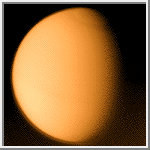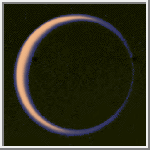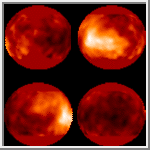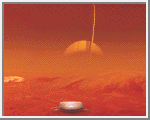 Titan
Titan
Saturn VI
Table of Contents
Additional Titan Resources:
Titan [TY-tun] is the largest moon of Saturn and the second largest
moon in the solar system, rivaled only by
Jupiter's moon
Ganymede.
Before the Voyager
encounters, astronomers suspected that Titan
might have an atmosphere. Scientists also believed
they might find liquid seas or pools of methane or ethane; water
would be frozen due to Titan's low surface temperature.
Expecting an unusual world, Voyager 1 was programmed
to take numerous close up views of Titan as it flew past in
November of 1980. Unfortunately, all that was revealed was an
impenetrable layer of atmosphere and clouds. Only slight color
and brightness variations were observed.
Although Titan is classified as a moon, it is larger
than the planets Mercury and Pluto.
It has a planet-like atmosphere which is
more dense than those of Mercury,
Earth, Mars
and Pluto. The atmospheric pressure
near the surface is about 1.6 bars, 60 percent greater than Earth's.
Titan's air is predominantly
made up of nitrogen with other
hydrocarbon elements which give Titan its orange hue. These
hydrocarbon rich elements are the building blocks for amino
acids necessary for the formation of life.
Scientists believe that
Titan's environment may be similar to that of the Earth's before
life began putting oxygen into the atmosphere.
Titan's surface temperature appears to be about -178°C
(-289°F). Methane appears to be below
its saturation pressure near Titan's surface; rivers and lakes of
methane probably don't exist, in spite of the tantalizing analogy
to water on Earth. On the other hand, scientists believe lakes
of ethane exist that
contain dissolved methane.
Titan's methane, through continuing photochemistry, is converted
to ethane, acetylene, ethylene, and (when combined with nitrogen)
hydrogen cyanide. The last is an especially important molecule;
it is a building block of amino acids.
The Voyager spacecraft were not able to penetrate the thick layers
of clouds but they did reveal that Titan is one of the more interesting
places in the solar system. What kind of landscape lies below the
layers of clouds? What mysteries are held beneath these orange curtains?
These questions will have to wait until future spacecraft are launched
to visit this unusual moon.
In October 1997, the
Cassini spacecraft
is scheduled
to be launched for a rendezvous with Saturn in June 2004.
Later that year, it will release the European-built Huygens probe
for a descent through Titan's atmosphere.
Cassini will have more than 30
encounters with Titan, mapping the moon's surface
with a synthetic aperature radar similar to the one Magellan used to map
Venus.
| Titan Statistics
|
|---|
| Discovered by | Christiaan Huygens
|
|---|
| Date of discovery | 1655
|
|---|
| Mass (kg) | 1.35e+23
|
|---|
| Mass (Earth = 1) | 2.2590e-02
|
|---|
| Equatorial radius (km) | 2,575
|
|---|
| Equatorial radius (Earth = 1) | 4.0373e-01
|
|---|
| Mean density (gm/cm^3) | 1.88
|
|---|
| Mean distance from Saturn (km) | 1,221,850
|
|---|
| Rotational period (days) | 15.94542
|
|---|
| Orbital period (days) | 15.94542
|
|---|
| Mean orbital velocity (km/sec) | 5.58
|
|---|
| Orbital eccentricity | 0.0292
|
|---|
| Orbital inclination (degrees) | 0.33
|
|---|
| Escape velocity (km/sec) | 2.65
|
|---|
| Visual geometric albedo | 0.21
|
|---|
| Magnitude (Vo) | 8.28
|
|---|
| Mean surface temperature | -178°C
|
|---|
| Atmospheric pressure (bars) | 1.5
|
|---|
 Titan
Titan
Opaque layers of clouds prevented
Voyager from seeing Titan's surface
during its 1980 flyby. The clouds over the southern hemisphere are
lighter in color than over the northern hemisphere.
There is a dark hood over the north pole.
(Credit: Calvin J. Hamilton)
 Titan Looking Back
Titan Looking Back
This view of Titan was taken from a position looking almost directly
back toward the Sun. Titan's hydrocarbon-rich nitrogen atmosphere
scatters sunlight in a forward direction over the limb around the
entire disk. The surface of Titan is obscured by a deep cloud layer.
The only visible markings are the dark north polar hood and a difference
in the brightness and color in the north and south hemispheres.
(Courtesy NASA/JPL)
 Mercator Map Of Titan
Mercator Map Of Titan
For the first time scientists have made images of the surface of
Titan. They
mapped light and dark features over the surface of the
satellite during nearly a complete 16-day rotation. One
prominent bright area they discovered is a surface feature
2,500 miles across, about the size of the continent of
Australia. This view of Titan is a Mercator projection with
latitude ranging from 40° south to 50° north and longitude
ranging from 0° to 360° (E longitude increasing to the right).
This image was constructed from images taken by the Hubble
Space Telescope during 14 observing runs between October 4 - 18, 1994.
The WideField/Planetary Camera 2 was used at near-infrared wavelengths
(between .85 and 1.05 microns). Titan's haze is
transparent enough in this wavelength range to allow
mapping of surface features according to their reflectivity.
(Courtesy Peter Smith, University of Arizona/NASA)
 Four Views of Titan
Four Views of Titan
This image shows four views of Titan by mapping the Mercator Map
onto a globe at four different orientations.
(Courtesy Peter Smith, University of Arizona/NASA)
 Huygens
Huygens
This artist's rendering shows the European Space Agency's Huygens
probe descending into the atmosphere of Saturn's moon Titan after
being released by NASA's Cassini spacecraft. Planned for launch
in October 1997, Cassini will reach Saturn in June 2004 and will
release the Huygens probe later that year.
(Courtesy ESA)
 Huygens on Titan's Surface
Huygens on Titan's Surface
This artist's rendering shows the Huygens
probe on the surface of Saturn's moon Titan after being released
by NASA's Cassini spacecraft.
(Courtesy ESA)
Burnham, Robert, "Hubble Maps Titan's Hidden Landscape," Astronomy,
44-45, February 1995.

 Saturn
Saturn
 Rhea
Rhea
 Hyperion
Hyperion

Copyright © 1997 by Calvin J. Hamilton.
All rights reserved.
 Titan
Titan
 Titan Looking Back
Titan Looking Back
 Four Views of Titan
Four Views of Titan
 Huygens
Huygens
 Huygens on Titan's Surface
Huygens on Titan's Surface

 Saturn
Saturn Rhea
Rhea Hyperion
Hyperion